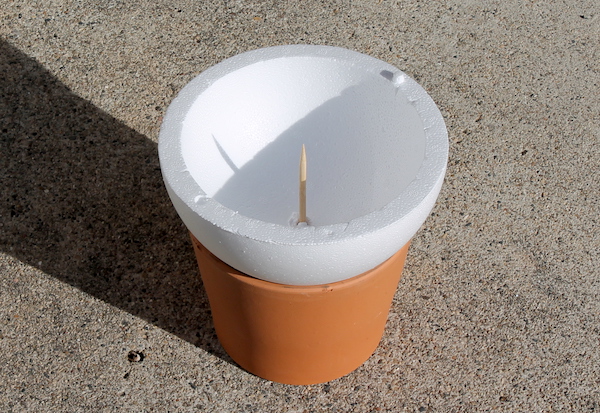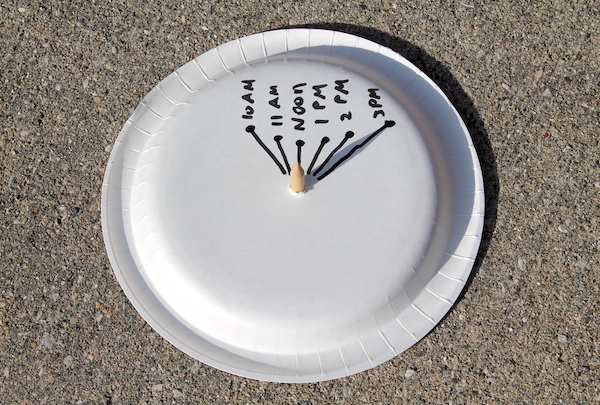Tracking the Sun by Tracking Shadows
What is the shape of the sun's path across your sky? Make your own sun-tracker from simple everyday parts.
If you search the web for “how to make your own sundial,” you will probably find several videos and web pages telling you that you can make a very simple sundial from a paper plate. You just draw a clock face on a paper plate, press a pencil or an apple skewer through the center, and then place it out in the sunshine.

Let's think about this for a minute. Can you think of some reasons why this simple “clock-face sundial” might not work so well? One obvious fact is that the sun rises and sets. The sundial can't tell time when the sun is down. Do you see any other problems?
A simple “clock-face” design like this might be a fun craft project, but it doesn't really seem like a proper scientific or mathematical instrument, does it? Can we make it more scientific? Let's start by stepping back and asking a bigger question: How would the sun have to move through the sky in order for the shadow of the stick to sweep around in a circle, like the hand of a clock? The sun would have to move sideways, wouldn't it? It would have to move in horizontal circles around and around in the sky, never climbing higher or sinking lower. Is that what the sun actually does in the sky? (There are actually two special places in the world where the sun really does this … but that's another story.)
To make a scientific sundial, we need to make a shadow-tracker that “fits” or matches the real path of the sun in the sky. We need to know the shape of the path of the sun across the sky, so that we can make a “shadow-tracker” with the same shape. The first scientific instruments in history were the geometric sundials made by the Ancient Greeks, and they were not just time-keeping devices, they were geometric “sun-trackers” for showing the exact shape of the sun's path across the sky. So let's start tracking shadows across the ground, and see if we can discover the true path of the sun across the sky, and the right shape to make a sundial. Let's find out for ourselves how shadows move across the ground, and how the sun moves across the sky.
Tracking Shadows in a Bowl
The sky above us is like a dome over our heads, isn't it? The horizon is like a circle all around us, at the bottom of the dome, and the sky directly over our heads is like the top of the dome. Could we make a “toy” or “model” version of the real dome and try to track the sun on it? Could we carry a bowl outdoors, and turn it upside-down so it is like a dome, and draw marks on it showing where the sun is at different times of day? Then when we connect the dots, we'd have a crude trace of the sun's path across the dome. That would be easy to do, but our marks would be kind of sloppy. Is there a way we can be more exact and scientific?
What would happen if we left the bowl right-side-up as a bowl instead of a dome, we placed something in the exact center to cast a shadow, and we put it out in the sunshine? The shadow of the thing in the center would fall on the bowl at a place exactly opposite to the sun in the sky. We wouldn't have to guess, the shadow would point to exactly the right position. And it will do this all day long, so we can make a trail or a trace across the bowl that exactly mirrors the trail or the path of the sun across the sky. The bowl would be an upside-down replica of the sky. We would have our own working model of the sky.

You can easily try this yourself. You can buy styrofoam hemispheres in most craft stores. For the pointy thing in the middle, you can use an apple skewer or a knitting needle or a dowel sharpened in a pencil sharpener. If you do this carefully, can you record and discover the exact geometric shape of the sun's path across the sky? If you try this in different months of the year, do you think the path will change, or will it stay the same? How do you think the path might change?
Once you have discovered the shape of the sun's path of the sun across your sky, you are ready to make a scientific sundial, by making a shadow-device with a matching shape.
Tracking Shadows of Vertical Posts
If you don't have a hemispherical bowl, another simple strategy would be to make marks on a horizontal surface, like a paper plate. You could just push a pencil through the middle of a paper plate, but instead of making the face of the sundial look like a clock ahead of time, you just put a blank paper plate in the sun and wait. The you can draw the marks yourself wherever the shadow falls for real at different times of the day. If you want to do this on a grander scale, maybe you can find a tether-ball pole and make marks with some sidewalk chalk. Or maybe you could mark the shadow of a fence post with stones or colorful stakes of some kind. I tried using a paper plate and a sharpened dowel, and I made this:

If I were to connect the dots, I would be drawing the path of the shadow of the dowel tip across the plate, and that path would be a “reflection” or an indication of the path of the sun across the sky. You can see that the path of the shadow on the plate is definitely not a circle around the center, like the hand of a clock. It does go “around” the center, but it actually seems to be curved the wrong way, for some bizarre reason. Why does the path seem to be curved? Is it always that way? If you try this yourself, will your shadows look like mine?